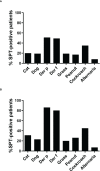Frequent IgE recognition of Blomia tropicalis allergen molecules in asthmatic children and young adults in equatorial Africa
- PMID: 37359512
- PMCID: PMC10286740
- DOI: 10.3389/fimmu.2023.1133935
Frequent IgE recognition of Blomia tropicalis allergen molecules in asthmatic children and young adults in equatorial Africa
Abstract
Background: Asthma is not well investigated in equatorial Africa and little is known about the disease-associated allergen molecules recognized by IgE from patients in this area. The aim was to study the molecular IgE sensitization profile of asthmatic children and young adults in a semi-rural area (Lambaréné) of an equatorial African country (Gabon), to identify the most important allergen molecules associated with allergic asthma in equatorial Africa.
Methods: Fifty-nine asthmatic patients, mainly children and few young adults, were studied by skin prick testing to Dermatophagoides pteronyssinus (Der p), D. farinae (Der f), cat, dog, cockroach, grass, Alternaria and peanut. Sera were obtained from a subset of 35 patients, 32 with positive and 3 with negative skin reaction to Der p and tested for IgE reactivity to 176 allergen molecules from different allergen sources by ImmunoCAP ISAC microarray technology and to seven recombinant Blomia tropicalis (Blo t) allergens by IgE dot blot assay.
Results: Thirty-three of the 59 patients (56%) were sensitized to Der p and 23 of them (39%) were also sensitized to other allergen sources, whereas 9 patients (15%) were only sensitized to allergen sources other than Der p. IgE serology analyses (n=35) showed high IgE-binding frequencies to the Blo t allergens Blo t 5 (43%), Blo t 21 (43%) and Blo t 2 (40%), whereas the Der p allergens rDer p 2, rDer p 21 and rDer p 5 (34%, 29% and 26%) were less frequently recognized. Only few patients showed IgE reactivity to allergens from other allergen sources, except to allergens containing carbohydrate determinants (CCDs) or to wasp venom allergens (i.e., antigen 5).
Conclusion: Our results thus demonstrate that IgE sensitization to mite allergens is very prevalent in asthmatics in Equatorial Africa with B. tropicalis allergen molecules representing the most important ones associated with allergic asthma.
Keywords: Blomia tropicalis; Dermatophagoides; allergen microarray; allergens; allergy; asthma; equatorial Africa.
Copyright © 2023 Pauli, Wurmser, Roos, Kokou, Huang, D’souza, Lupinek, Zakzuk, Regino, Acevedo, Caraballo, Vrtala and Valenta.
Conflict of interest statement
Author RV has received research grants from HVD Life Science, Vienna Austria, WORG Pharmaceuticals, Hangzhou, China and Viravaxx, Vienna, Austria and serves as a consultant for WORG and Viravaxx. Author CL is currently employee of Macro Array Diagnostics, Vienna, Austria. The remaining authors declare that the research was conducted in the absence of any commercial or financial relationships that could be construed as a potential conflict of interest.
Figures







Similar articles
-
Skin test reactivity to natural and recombinant Blomia and Dermatophagoides spp. allergens among mite allergic patients in the UK.Allergy. 2003 Jan;58(1):53-6. doi: 10.1034/j.1398-9995.2003.23354.x. Allergy. 2003. PMID: 12580807
-
Indoor mite allergen levels, specific IgE prevalence and IgE cross-inhibition pattern among asthmatic children in Haikou, southern China.Chin Med J (Engl). 2012 Sep;125(17):3059-63. Chin Med J (Engl). 2012. PMID: 22932181
-
Characterization of a hybrid protein designed with segments of allergens from Blomia tropicalis and Dermatophagoides pteronyssinus.Immunol Lett. 2018 Apr;196:103-112. doi: 10.1016/j.imlet.2018.01.012. Epub 2018 Feb 3. Immunol Lett. 2018. PMID: 29408409
-
Blomia tropicalis: A 50-Year History.J Allergy Clin Immunol Pract. 2025 Jun;13(6):1289-1297. doi: 10.1016/j.jaip.2024.11.007. Epub 2024 Nov 20. J Allergy Clin Immunol Pract. 2025. PMID: 39577660 Review.
-
[Blomia tropicalis: A house dust mite in the tropics].Rev Mal Respir. 2017 Oct;34(8):791-801. doi: 10.1016/j.rmr.2016.10.877. Epub 2017 May 12. Rev Mal Respir. 2017. PMID: 28502519 Review. French.
Cited by
-
Predicting Blomia tropicalis allergens using a multiomics approach.Clin Transl Allergy. 2023 Oct;13(10):e12302. doi: 10.1002/clt2.12302. Clin Transl Allergy. 2023. PMID: 37876035 Free PMC article.
References
-
- Ait-Khaled N, Odhiambo J, Pearce N, Adjoh KS, Maesano IA, Benhabyles B, et al. . Prevalence of symptoms of asthma, rhinitis and eczema in 13- to 14-year-old children in Africa: the international study of asthma and allergies in childhood phase III Allergy. (2007) 62:247–58. doi: 10.1111/j.1398-9995.2007.01325.x - DOI - PubMed
Publication types
MeSH terms
Substances
LinkOut - more resources
Full Text Sources
Medical
Miscellaneous

